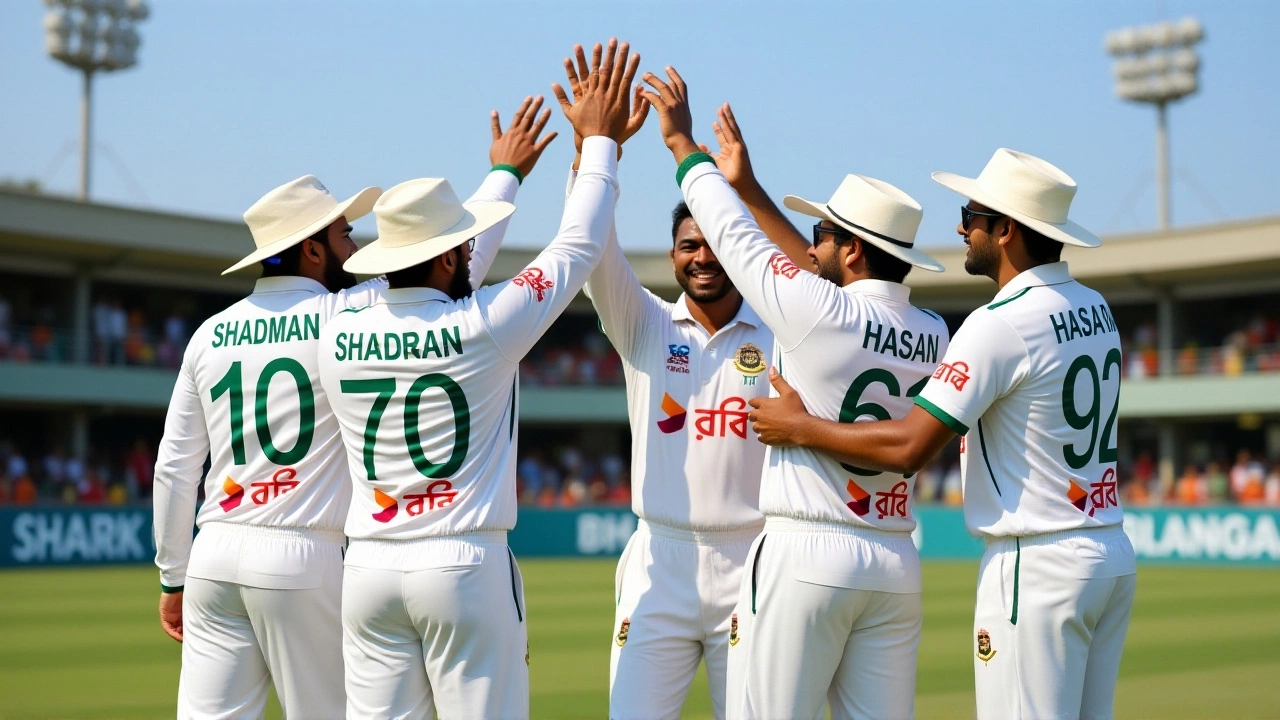When Bangladesh Cricket Board scheduled Ireland’s 2025 tour, few expected the visitors to be so thoroughly outclassed — but Litton Das’s 128 and Mahmudul Hasan Joy’s 171 didn’t just win matches. They exposed a chasm in skill, temperament, and adaptability between the two teams. The second Test, played at the Sher-e-Bangla National Cricket Stadium in Dhaka from November 19–23, 2025, saw Bangladesh post 476 in their first innings, putting Ireland in a familiar, hopeless position. The twist? This wasn’t a fluke. It was the culmination of a pattern that’s been building since their last meeting in 2023.
A Commanding Start, Built on Experience
The first Test in Sylhet, from November 11–15, set the tone. Bangladesh declared at 587/8, a total that still echoes in dressing rooms across Dublin. Joy’s 171 wasn’t just his maiden Test century — it was his first 150, and the innings that announced his arrival as a cornerstone of Bangladesh’s middle order. He faced 286 balls with the patience of a veteran and the aggression of a man who knew the conditions would favor him. Meanwhile, Ireland collapsed twice — 286 and 254 — with only Paul Stirling’s 60 offering any resistance. Mehidy Hasan Miraz and Hasan Murad, the latter making his debut, tore through the Irish batting with precision. The result? A win by an innings and 47 runs. No margin for error. No escape.Litton Das Carries the Torch
The second Test began with a quiet intensity. At 9:30 AM local time on November 19, Bangladesh walked out to bat under a humid Dhaka sky. By lunch, the scoreboard read 150/0. The reason? Litton Das. His 128 from 192 balls wasn’t flashy, but it was authoritative — a masterclass in reading spin, rotating strike, and punishing loose deliveries. He didn’t just score runs; he dictated terms. Ireland’s attack, led by Andy McBrine — who took 6/109, his career-best — looked exhausted by the third hour. McBrine’s effort was heroic, but it was like trying to hold back a tide with a broom. And then came the milestone. Mushfiqur Rahim walked out for his 100th Test. The crowd rose. The broadcasters fell silent. He didn’t score a century. He didn’t need to. He and the retired Mashrafe Bin Mortaza — referred to in commentary as “Mashik Rahim” — added 92 unbroken runs between them, a masterclass in patience and control. The crowd chanted. The Irish bowlers looked bewildered. This wasn’t just cricket. It was a lesson in legacy.
Historical Dominance, Not Luck
Look at the numbers, and you’ll see this isn’t new. In their only previous Test meeting — in 2023 — Bangladesh won by 155 runs after Ireland, chasing 288, collapsed from 51/5. Lorcan Tucker’s debut century (108) was a rare bright spot, but even that couldn’t stop the tide. In ODIs, Bangladesh has won 11 of 16. In T20Is, it’s 5 wins to Ireland’s 2. The gap isn’t narrowing. It’s widening. Ireland’s problem? They’re still playing like a team that believes Test cricket is a novelty. Bangladesh? They’re playing like a team that knows it belongs here. The conditions — slow pitches, variable bounce, relentless spin — aren’t foreign to them. They’re home. And Ireland, despite their passion and grit, are still learning how to navigate them.What Comes Next?
The two-match Test series is effectively over. Bangladesh leads 1-0. With the final result all but sealed, attention now shifts to the three T20Is, starting December 1 in Dhaka. But make no mistake — this tour has already rewritten the narrative. Bangladesh isn’t just beating Ireland. They’re outgrowing them. And the world is watching.For Ireland, the path forward is clear: more time in Asia, more exposure to spin-heavy conditions, and a fundamental shift in mindset. For Bangladesh, it’s about building on this momentum — turning dominance into consistency, and Test wins into World Test Championship points.

Behind the Scenes
The Bangladesh Cricket Board, headquartered in Mirpur, Dhaka, quietly restructured their home schedule in September 2025 after Cricket Ireland requested the removal of the ODI leg. The original plan — two Tests, three ODIs, three T20Is — became two Tests and three T20Is. The decision, while framed as logistical, was likely strategic: Bangladesh wanted to focus on Test cricket’s growing importance, and Ireland, with its limited depth, couldn’t sustain a full-format tour. Broadcast rights are held by T Sports, with highlights streaming on YouTube. Live stats, including wagon wheels and ball-by-ball analytics, are tracked by Sofascore, revealing how Bangladesh’s spinners consistently forced Ireland into defensive, low-percentage shots.Frequently Asked Questions
How did Litton Das’ 128 compare to other top scores by Bangladeshi batters against Ireland?
Das’ 128 in the second Test is now the highest individual score by a Bangladeshi batter against Ireland in Test cricket, surpassing Tamim Iqbal’s 118 in 2018. It’s also the first Test century by a Bangladeshi keeper-batsman since Mushfiqur Rahim’s 134 against Zimbabwe in 2020. His strike rate of 66.67 under pressure marks him as one of Bangladesh’s most reliable middle-order anchors.
Why did Ireland lose both Tests so decisively?
Ireland’s batting lacks experience against high-quality spin in subcontinental conditions. In both Tests, their top order failed to adapt to the turn and bounce. Their average first-innings score in Asia over the last five years is just 198 — well below the global average of 275. Without a specialist spinner of their own, they’re also vulnerable in the fourth innings when chasing.
What does Mushfiqur Rahim’s 100th Test mean for Bangladesh cricket?
Rahim is only the third Bangladeshi to reach 100 Tests, after Shakib Al Hasan and Mushfiqur himself (he’s also the first wicketkeeper to do so). His presence bridges the gap between the golden generation of 2005–2015 and today’s young core. His leadership in the final session of the second Test — guiding younger players through pressure — is invaluable for Bangladesh’s transition into a consistent Test side.
Is this series a sign Bangladesh can compete in the World Test Championship?
Absolutely. Winning by an innings against a Test-playing nation — even one ranked lower — is exactly the kind of result the WTC needs from emerging teams. Bangladesh now have 120 points from their last three home Tests. If they can replicate this against Sri Lanka or Zimbabwe in 2026, they’ll be firmly in contention for the final.
What’s the significance of removing ODIs from the tour?
It reflects a strategic shift by both boards. Bangladesh prioritizes Test cricket for global credibility, while Ireland — lacking depth — focused on T20Is for revenue and exposure. ODIs, which require deeper squads and longer tours, were deemed unsustainable. The decision highlights how smaller nations are adapting to a two-format future: Tests for prestige, T20Is for survival.
Who are the key players to watch in the upcoming T20Is?
For Bangladesh, Mahmudul Hasan Joy is emerging as a finisher, while spinner Mehidy Hasan Miraz has improved his death-over economy. For Ireland, Paul Stirling remains their most dangerous batter, and young all-rounder Cade Carmichael — who debuted in the first Test — could be their X-factor if he finds form.
